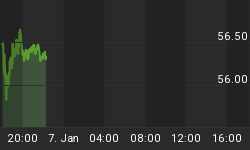Originally published January 20th, 2008.
While the general public were having their vacuous minds stuffed with irrelevant trivia about the US primaries late last week, the gathering maelstrom in the stockmarkets was treated as a minor sideshow by the mainstream media. Like revellers at a giant outdoor fiesta or open air society wedding that is about to be trashed by a violent thunderstorm, they are going to find out just how fast things can change - and what really matters.
In The Tragedy of the US Stockmarket Part 1 posted on the 8th January we examined the overwhelming technical evidence pointing to an imminent breakdown by US stockmarkets. This breakdown occurred last week as the PPT (Plunge Protection Team) failed to successfully defend the critical support line at the lows of last August. The PPT are now in emergency session and panic has broken out behind the scenes in Washington, leading to the desperate measures announced by the administration on Friday. As this administration and the Federal Reserve no longer have a shred of credibility, the emergency measures just announced, which reek of desperation and panic, and any announced in the near future, are only likely to exacerbate the crisis.

On the 2-year chart for the S&P500 index we can see how it last week breached key support by a substantial margin to break down from the Dome Top that had been slowly developing from the low of March of last year, with the 200-day moving average now finally rolling over. Going on this chart alone you wouldn?t think it had much further to fall - after all it is near the bottom of the chart and the short-term oscillators at the top and bottom of the chart are showing that it is at or near its normal oversold limit. These are not normal times however, and major panics have no respect for normal oversold limits or support levels, for that matter. To get more of an idea just how far it could fall, we will now look at a longer-term chart going back to early 2002.

On the longer-term 6-year chart from 2002 we can see the bull market advance from early 2003 in its entirety, but as we have already observed, to call it a bull market is a misnomer - it is actually nothing more than an extended bear market rally, as is made abundantly clear by the chart for this index plotted in Euros, which filters out the distortion of the big drop in the dollar in recent years. On this chart we can see that last week the index finally broke down from the (weak) long-term uptrend in force from mid-2004, and did so on heavy volume, emphasizing the bearishness of this development. In considering how far it is now likely to drop, it should be borne in mind that the fundamental outlook is infinitely worse than that prevailing around the time of the early 2003 low. Details of these fundamentals are beyond the scope of this article, which is primarily technical in nature. Many readers will by now have some idea of the core fundamental issues and problems but for more detailed analysis readers are referred to the recent work of Jim Willie and Peter Schiff, who in the writer?s opinion, have their respective fingers on the pulse of what is really going on much more than most. Normally, within a few days of another lame scheme being announced to paper over the cracks and keep things limping along a bit longer, Peter Schiff cuts into it like a circular saw, leaving the reader in no doubt as to the underlying motivations behind it and the end result of it. The fundamental outlook for the US is appalling, for various important reasons, and therefore it is not unreasonable to expect the US stock markets, following their major breakdown last week, to plunge rapidly back to their 2003 lows, and probably substantially lower. This will be the case even if we see a minor rally short-term back into the earlier important support zone, which is now resistance, i.e. back to the 1375 area, which would partially unwind the current deeply oversold condition, but given the transparently obvious desperation behind the measures announced late last week which might cause a rally, an acceleration in the freefall is considered more likely.

The long-term chart going back to the early 90?s reveals that the S&P500 has just completed a massive Double Top with its highs of 2000. With the second top area having just completed and the index having also broken down from the uptrend from the central trough, there is nothing technically to stop it dropping back at least to the vicinity of the central near the central trough, and perhaps a lot lower. A point to note is that is that the current confluence of exceptionally bearish factors, which aren?t going away anytime soon and instead will get a lot worse, means that the decline from the second peak could easily be a lot swifter than the decline from the first.

The advance from the 2002 - 2003 trough was only ever a bear market rally, as is made very clear by plotting the S&P500 chart in Euros. The long-term chart in Euros starkly exposes this reality, and with the weak uptrend, which took the form of a bearish Rising Wedge, having failed, the prospect is of a steep decline taking the index back to support near its 2003 lows as a minimum objective - and it is likely to drop much lower.















